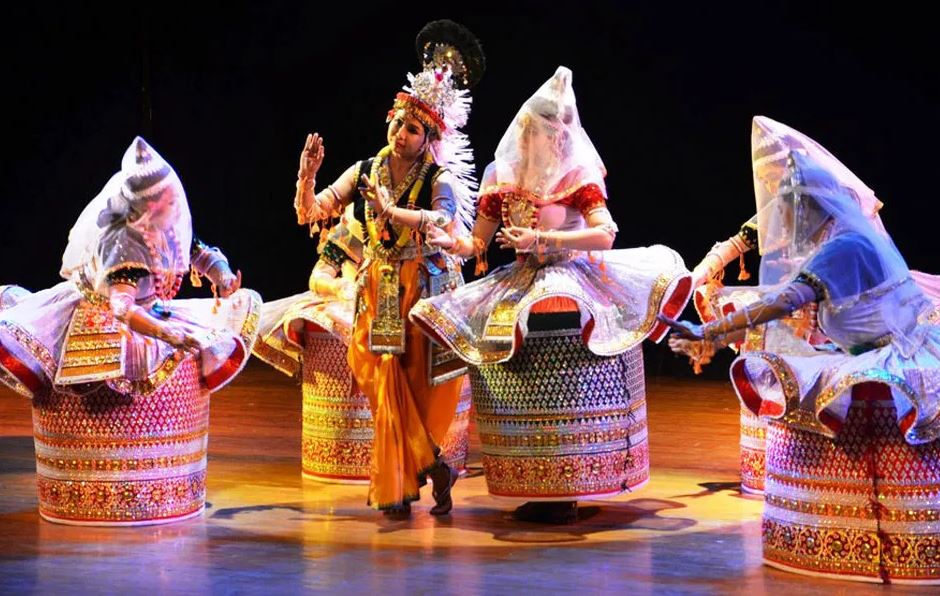From the volume “Confluence: Essays on Manipuri Literature and Culture” by the author, compiled and edited by B.S. Rajkumar
Guru Haobam Atomba and Guru Nadiya
Among those gurus who taught Manipuri dance at Gurudeva Rabindranath’s Shantiniketan Haobam Atomba Singh (1885-1975) is especially worthy of accounting. As requested by Gurudeva, he stayed at Shantiniketan for about 15 years as a teacher for Manipuri dance. When the World War-II broke out and bombing to cause people flee from war occurred at Imphal, he came back to Manipur. Guru Haobam Atomba was a teacher who Rabindranath respected highly. He brought out many a famous male and female students of Manipuri dance at Shantiniketan. When the Jawaharlal Nehru Manipur Dance Academy got established at Imphal in 1954 he became a teacher there, continued to be so for quite a long time, and he received the Sangeet Natak Academy Award from the hand of the President of India in 1958.
Late Guru Tourangbam Nadiya did not work at Rabindranath’s Shantiniketan as a teacher of Manipuri dance; rather was a teacher at the Rabindra Bharati Vishwavidyalaya. In 1962 when Dr. B.C. Roy was the Chief Minister of the West Bengal, the government took over the residential building, the lot around it and all the immovable properties of Rabindranath Thakur; and established there the ‘Rabindra Bharati Vishwabidyalaya’. Specially inviting a number of famous gurus and teachers of dance, music and theatre of the time. they made them teachers there including those of Manipuri dance. When Guru Nadiya was a teacher there he produced Rabindranath’s Chandalika recreating it in the style of Manipuri dance. It turned out to be very famous.
The style of Rabindranath’s Dance and Nrityanatya
The style, technique and the overll feature of Rabindranath’s dance can be seen in his Nrityanatyas (Dance Dramas). Specially in his famous Nrityanatya like Natir Pooja, Rituranga, Chitrangada, Chandalika, Shyama and others, his beautiful creation of styles is visible. Rabindranath selected only two kinds of Indian dances and he let these two be taught at Shantiniketan, and they are Manipuri Dance and Kerala’s Kathakali. Picking out the sinuous movements of the body and limbs appropriate for the expression of the heart’s emotions and feelings, congruous with the theme and story in these two kinds of dance, his was to dance accompanied with song and music. In his creation of dances, he did not follow particular rules and regulations strictly nor did he take after the tradition of the scripture (shatra). He chose constituents whichever he felt like to; his was rather more of a free composition. But the manoeuvre of eyes, neck, rump, as often practiced in other Indian dances, is hardly seen in his style.
In Rabindra’s dance, song and poetry play important roles. His dance is kind of a ‘song-dance’. When shown on the stage too, he always tried to show in the line of the ethos of Indian stage, not in the kind of the West. He always sought for the soft, mellow and sinuous movements of retrained rhythm seemingly with the rune of the song. That was how he found the style of Manipuri dance so suitable. His Nrityanatya Chitrangada was created based on Manipuri style, Rituranga on the style of Java’s dance and Chandalika on the style of the South Indian Kathakali and, at that, he always delivered the goods as a new fresh creation. “Though Chitrangada is based on the Manipuri technique, nowhere in that area will be found a play like it. Similarly, Chandalika, created in the South Indian technique, will not be recognised in the dances there. Such is the fusion of the style. It is like a chemical compound (Pratima Tagore). Most of the dance dramas of Rabindranath take after the forms and features of Indian art of dance. He uses plenty of the components of nritya, abhinaya and geet. However, underneath this use, there is a cool temper where exultation is subdued, rather are there gentleness fulfilling joy and beauty. Projesh Banerjee remarks, ‘…all are presented in a highly refined and pleasing blend and the setting always austere and subdued‘.
At the end what Projesh Banerjee said reminds us further. “It should be remembered that our country is highly indebted to Rabindmnath Tagore for his novel and artistic ida regarding his own particular school and type of oriental dance’ This pervading atmosphere of freedom which is inherent in the poet and which is uppermost in all his activities is easily noticed in the particular school of dancing of which he is the originator, He is never curbed down, checked and burdened by any rules of law. He is not at all hindered by them, but is ever anxious for sweetness, grace, sublimeness and excellence. The codified matter of facts, rules regarding tunes and Ragas in songs, intricate Tals in dancing and painting do not come in his way, he is carried on by his own whims. He is spontaneous as a stream, gay as a deer, wild as the wind and free as the bird.”
References
- Rabindranath Tagore :Centenary Number (1861-1961), Sangeet Natak Akademi. New De1hi,1961.
- Mandatantra Bose: Speaking of Dance, The Indian Critique, K. Printworld (Pvt.) Ltd, New Delhi. 2001
- Projesh Banerjee: Art of Indian Dancing, Sterling Publications (Pvt.) Ltd. New Delhi, 1985
- Shantideva Ghosh: Gurudeva Rabindranath 0 Adhunik Bharatiya Nritya, Anand Publications, Calcutta, 1933
- Mohan Khokar: Dances of India, Vivekananda Patrika, Madras, 1981
- Rabindranath O Tripura, 1961
- Biramangol Singh : Itihas kee Mityeng Dagee Tripura-Manipur, Akshar Publications, Tripura, 2007
- Souvenir: Guru Atomba Birth Centenary Celebration, October 05-06, 1986












